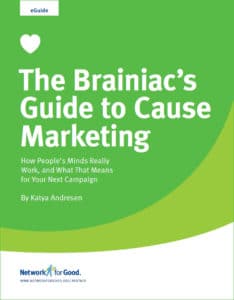 If you aren’t incorporating behavioral science to your advantage when developing your cause marketing and communication strategies, then you are missing a huge opportunity. You may have a great cause and you may even have some seriously great corporate partners, but with the wrong approach comes a huge opportunity cost. “The Braniac’s Guide to Cause Marketing – How People’s Minds Really Work, and What That Means for Your Next Campaign” a free 13-page e-guide created by Katya Andresen for Network For Good, provides a great overview of relevant studies and why you should apply this thinking to your corporate partnership and fundraising work.
If you aren’t incorporating behavioral science to your advantage when developing your cause marketing and communication strategies, then you are missing a huge opportunity. You may have a great cause and you may even have some seriously great corporate partners, but with the wrong approach comes a huge opportunity cost. “The Braniac’s Guide to Cause Marketing – How People’s Minds Really Work, and What That Means for Your Next Campaign” a free 13-page e-guide created by Katya Andresen for Network For Good, provides a great overview of relevant studies and why you should apply this thinking to your corporate partnership and fundraising work.
To follow are some key take-aways that will surely inspire you to download and read the full document:
STUDIES SHOW THAT THE EMOTIONAL MIND TRUMPS THE THINKING MIND WHEN IT COMES TO RAISING MONEY FOR A CAUSE:
- “The amount people gave was affected by the degree of empathy they felt…Feeling beat thinking in dollars donated.”
- “People are twice as likely to give a charitable gift when presented with an emotion-inducing personal story that focuses exclusively on one victim’s plight, rather than a group of “unnamed statistical victims.”
GIVING FEELS GOOD:
- “First, focus on that fact that, above all, you are in the happiness business. Your primary job is to find the emotional core of your initiative and connect it to the consumers you wish to reach. Then give them the opportunity to feel great by doing good.”
MAKE IT PERSONAL TO GET RESULTS:
- Learn how to leverage these types of common human behavior to increase empathy, thereby increasing support for your cause/fundraiser: “norm of self-interest,” “identifiable victim effect” or “singularity effect,” and “psychic numbing.” Get to the heart of this science jargon with relatable examples and studies that you can easily apply to your communication strategies.
HOW CSR DRIVES PRODUCT PERCEPTION MAY SURPRISE YOU:
- “It’s critical that the company, not necessarily the product, is viewed as socially ‘good.’”
- The consumer wants a high quality product. Sometimes too much focus tied to a particular product can make consumers skeptical of the actual quality of the product, whether accurate or not.
CLEARLY STATING THE IMPACT MAKES THE MESSAGE MORE COMPELLING:
- “Marketers often talk about causes in intangible terms, and that doesn’t work very well.”
- Be transparent, specific and personal about the impact of participating to see significant increases in support.
PEER PRESSURE WORKS IN BOTH DIRECTIONS:
- People act based upon “social norms,” both positive and negative. Frame your call to action message appropriately to drive the behavior you desire.
THERE ARE NUANCES TO THE BENEFITS OF EMPOWERING CONSUMERS TO CHOOSE:
- Studies show that consumers are more engaged when they have the power to choose the beneficiary.
- Factors such as proximity to goal, relevance of cause, cultural norms and number of options can influence the degree of influence that consumer choice delivers.
OK…lots of great stuff there! You should be sufficiently inspired to begin tweaking your cause marketing communications to better leverage the science of human behavior. Download the easy-to-read-and-apply “Braniac’s Guide To Cause Marketing” here which includes great examples and many more key take-aways to help you create your most effective cause partnerships and campaigns…all the smart marketers are doing it (peer pressure!!!). Enjoy! Trisha

